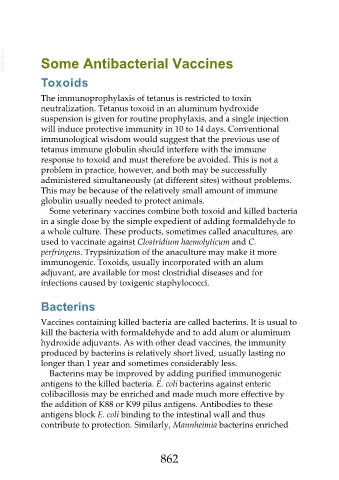Page 862 - Veterinary Immunology, 10th Edition
P. 862
VetBooks.ir Some Antibacterial Vaccines
Toxoids
The immunoprophylaxis of tetanus is restricted to toxin
neutralization. Tetanus toxoid in an aluminum hydroxide
suspension is given for routine prophylaxis, and a single injection
will induce protective immunity in 10 to 14 days. Conventional
immunological wisdom would suggest that the previous use of
tetanus immune globulin should interfere with the immune
response to toxoid and must therefore be avoided. This is not a
problem in practice, however, and both may be successfully
administered simultaneously (at different sites) without problems.
This may be because of the relatively small amount of immune
globulin usually needed to protect animals.
Some veterinary vaccines combine both toxoid and killed bacteria
in a single dose by the simple expedient of adding formaldehyde to
a whole culture. These products, sometimes called anacultures, are
used to vaccinate against Clostridium haemolyticum and C.
perfringens. Trypsinization of the anaculture may make it more
immunogenic. Toxoids, usually incorporated with an alum
adjuvant, are available for most clostridial diseases and for
infections caused by toxigenic staphylococci.
Bacterins
Vaccines containing killed bacteria are called bacterins. It is usual to
kill the bacteria with formaldehyde and to add alum or aluminum
hydroxide adjuvants. As with other dead vaccines, the immunity
produced by bacterins is relatively short lived, usually lasting no
longer than 1 year and sometimes considerably less.
Bacterins may be improved by adding purified immunogenic
antigens to the killed bacteria. E. coli bacterins against enteric
colibacillosis may be enriched and made much more effective by
the addition of K88 or K99 pilus antigens. Antibodies to these
antigens block E. coli binding to the intestinal wall and thus
contribute to protection. Similarly, Mannheimia bacterins enriched
862

